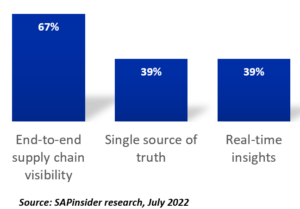SAPinsider will be publishing a research report,
Supply Chain Planning in The Cloud this month. As the survey for this research come to a close, many interesting insights emerge. One of the key ones is how SAPinsiders view supply chain planning as an important tool to build business resiliency and agility. Since the top business drivers focus on resiliency and agility, strategies that SAPinsiders are formulating to address business drivers also revolve around resiliency and agility. This
SAPinsider article covers the top drivers that were highlighted by respondents.
SAPinsiders are formulating or implementing strategies to address their business drivers. The top strategies they have identified for building robust supply chain planning capabilities are shown in figure 1. Building end-to-end visibility (67%), Developing a single source of truth for the end-to-end supply chain (39%), and leveraging real-time insights (39%), all pertain to the resiliency and agility and support associated business drivers.
Figure 1. Top strategies to address business drivers

Since the top business drivers focus on resiliency and agility, strategies that SAPinsiders are formulating revolve around these as well. Building end-to-end visibility (67%), Developing a single source of truth for the end-to-end supply chain (39%), and leveraging real-time insights (39%), all pertain to the resiliency and agility and support associated business drivers.
The need to improve supply chain visibility needs to be supported by having end-to-end supply chain visibility so it is not surprising that it emerged as the top strategy. The supply chains that most organizations need to leverage to deliver customer expectations are becoming increasingly complex due to global footprints, product proliferation, systems complexity, and evolving intricacies of key processes like logistics and inventory management. These complexities lead to more risk exposure across the supply chain. This increased risk, in turn, significantly increases the probability of supply chain disruptions, which may then impact customer satisfaction. In order to better manage supply chain risks and disruptions and build capabilities to deliver the right product in the right quantity and at the right time to enhance customer satisfaction, organizations need end-to-end visibility, control, and planning in their supply chains. The good news is that technology solutions in the SAP technology ecosystem are powerful enablers for organizations looking to build supply chain visibility.
SAP has also partnered with solution providers like
Project 44 and
Four Kites to extend the powerful visibility capabilities that are already embedded in its solutions. Products like
SAP Business Networks take the collaboration and visibility opportunities beyond the network of an organization and into the network of suppliers and business partners.
Fragmentation of data remains a key obstacle on the path of integrated supply chain planning. Many organizations have invested in point systems for planning various elements of supply chains over the years, have legacy systems, and also have data pertaining to supply chain residing in enterprise systems like ERP, CRM etc. With the advent of Big Data, the number of data sources and opportunities for data fragmentation have also increased. Supply chain data is therefore fragmented in data silos across multiple systems and data sources across the enterprise. This is one of the factors behind SAPinsiders selecting creating a "single-source-of-truth" as one of their key strategies as it pertains to supply chain planning.
This article shares additional insights on how to eliminate data silos in supply chains.
 Since the top business drivers focus on resiliency and agility, strategies that SAPinsiders are formulating revolve around these as well. Building end-to-end visibility (67%), Developing a single source of truth for the end-to-end supply chain (39%), and leveraging real-time insights (39%), all pertain to the resiliency and agility and support associated business drivers.
The need to improve supply chain visibility needs to be supported by having end-to-end supply chain visibility so it is not surprising that it emerged as the top strategy. The supply chains that most organizations need to leverage to deliver customer expectations are becoming increasingly complex due to global footprints, product proliferation, systems complexity, and evolving intricacies of key processes like logistics and inventory management. These complexities lead to more risk exposure across the supply chain. This increased risk, in turn, significantly increases the probability of supply chain disruptions, which may then impact customer satisfaction. In order to better manage supply chain risks and disruptions and build capabilities to deliver the right product in the right quantity and at the right time to enhance customer satisfaction, organizations need end-to-end visibility, control, and planning in their supply chains. The good news is that technology solutions in the SAP technology ecosystem are powerful enablers for organizations looking to build supply chain visibility.
Since the top business drivers focus on resiliency and agility, strategies that SAPinsiders are formulating revolve around these as well. Building end-to-end visibility (67%), Developing a single source of truth for the end-to-end supply chain (39%), and leveraging real-time insights (39%), all pertain to the resiliency and agility and support associated business drivers.
The need to improve supply chain visibility needs to be supported by having end-to-end supply chain visibility so it is not surprising that it emerged as the top strategy. The supply chains that most organizations need to leverage to deliver customer expectations are becoming increasingly complex due to global footprints, product proliferation, systems complexity, and evolving intricacies of key processes like logistics and inventory management. These complexities lead to more risk exposure across the supply chain. This increased risk, in turn, significantly increases the probability of supply chain disruptions, which may then impact customer satisfaction. In order to better manage supply chain risks and disruptions and build capabilities to deliver the right product in the right quantity and at the right time to enhance customer satisfaction, organizations need end-to-end visibility, control, and planning in their supply chains. The good news is that technology solutions in the SAP technology ecosystem are powerful enablers for organizations looking to build supply chain visibility. 








